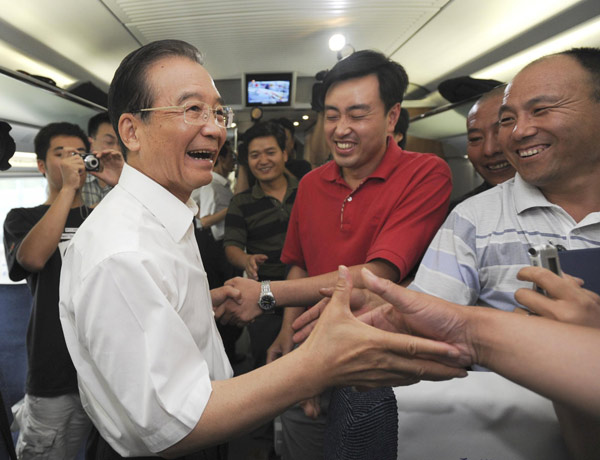Wen boards bullet train on debut operation
 0 Comment(s)
0 Comment(s) Print
Print E-mail
Xinhua, July 1, 2011
E-mail
Xinhua, July 1, 2011
Premiere Wen Jiabao on Thursday joined other passengers to board the first bullet train on the landmark high-speed railway between the metropolises of Beijing and Shanghai, calling it a "new chapter" in China's railway history.
 |
|
Premiere Wen Jiabao shakes hands with other passengers while travelling on the first bullet train of the landmark high-speed railway from Beijing to Shanghai, June 30, 2011. |
Before an inauguration ceremony held at the Beijing South Railway Station, Wen visited passengers at the waiting hall and listened to a report by the Ministry of Railways (MOR) on the construction and operation of the Beijing-Shanghai high-speed railway.
Wen said the railway's construction was an important decision by the state and of great significance to improve the country's modern transportation system, promote the economic and social development, and satisfy people's need for swift movement.
It took 38 months to complete the 1,318-km railway.
Even though the Beijing-Shanghai high-speed railway has started operation, railway officials and managers still face arduous tasks to ensure the operation is safe, orderly and efficient, the premier said.
"Railway departments must give top priority to the safety (of operation) while continuing to improve their service quality," Wen said.
He stressed the importance of scientific planning, coordination of different transportation systems and increasing the overall efficiency and comprehensive revenue of the transport industry as China ushers in an era of massive railway development.
After a brief inauguration ceremony, Wen and Vice-Premier Zhang Dejiang boarded the first bullet train G1 of the CRH380 series, which were independently developed by China.
Upon the order of the Minister of Railways Sheng Guangzu, the train departed Beijing South Railway Station at 3 pm. The train accelerated to 300 kmph only 10 minutes after leaving Beijing.
Wen visited passengers, including 25 workers who participated in the constructions of the rail line.
"I have the same feeling as you all -- it's fast and comfortable," Wen said.
Wen told passengers that the pricing of high-speed railways must satisfy demands of different kinds of consumers, saying the country will keep the current passenger rail lines that run at ordinary speeds while developing high-speed rails.
"Different transportation on the railways, the roads, in the air and the waterways should compete and coordinate with each other to facilitate the economic and social development to satisfy people's needs," he said. Wen got off the train 21 minutes later when it arrived at Langfang Station, one of the 24 stations along the route.
The railway links China's most prosperous regions of the Pan-Bohai areas and Yangtze River Delta economic zones, cutting travel time between the two regions to about five hours.
The high-speed railway, which has been operating on a trial basis since mid-May, opened one year ahead of schedule.
"After three years of our hard work, the big day finally arrived," said Wang Shoutian, an employee of China Railway's 12th Bureau Group Co., which worked on the rail line's construction. "Only 25 workers from our company were chosen to take the first bullet train, and I'm one of the lucky guys -- I'm very proud and excited."
Pei Zhiqiang, manager of China Communications Construction Co, said "The launch of the rail line shows our country's strength in the railway sector; all our hard work was worthwhile."
Although the railway is designed to handle maximum speeds of 350 kmph, most of the trains will run at speeds between 250 and 300 kmph.
He Huawu, chief engineer at the Ministry of Railways, on Monday dismissed rumors that the railway's operating speed was cut due to safety concerns.
"The adjustment to the operating speed of the railway was made to meet people's needs, to increase transport capacity and reduce costs and energy consumption," he said.
Tickets for the railway's fastest trains, running at 300 kmph, are priced between 555 yuan ($86) and 1,750 yuan. Prices for slower trains, running at 250 kmph, are priced between 410 yuan and 650 yuan.
The railway is expected to transport more than 80 million passengers annually, according to the MOR.
Sun Zhang, professor at the Shanghai Tongji University, said the launch of the line will help promote urban-rural integration and sustainable regional development.
With 24 stops, the railway is expected to bring new development opportunities to the cities along the line. For example, Qufu, hometown of Confucius, had no direct trains to Shanghai before the launch of the rail line.
Han Fengju, deputy head of the local tourism bureau in the city of Qufu, expects the new line will help boost local tourism.
"Visitors are likely to increase by 20 percent this year," he said.
The launch of the high-speed rail also brought a larger number of passengers to Beijing's subways on Thursday, especially to Line 4, which links the Beijing South Railway Station, the starting station of the bullet train, according to the metro management.
Metro Line 4 is expected to see 140,000 passengers daily after the launch of the high-speed rail, 50 percent up from the previous number, and during the summer vacation, a peak season for travelling, the subway line will carry a daily average of 970,000 people, a management official said.






Go to Forum >>0 Comment(s)